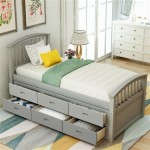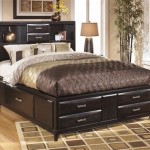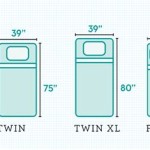How Wide Is A Full Size Bed In Inches?
Understanding bed sizes is crucial when furnishing a bedroom, whether it's for a master suite, a guest room, or a child's bedroom. Among the various options available, the full-size bed, also known as a double bed, holds a significant place due to its versatility and space-saving benefits. Accurately knowing the dimensions of a full-size bed, particularly its width in inches, is essential for planning room layouts, selecting appropriate bedding, and making informed purchasing decisions.
This article will delve into the specific width of a full-size bed in inches, along with a comprehensive overview of its overall dimensions, suitable room sizes, and comparisons with other bed sizes. Furthermore, considerations for choosing between a full-size bed and alternatives will be discussed, providing readers with the information necessary to make the best choice for their individual needs and circumstances.
Standard Dimensions of a Full Size Bed
The standard dimensions of a full-size bed are typically defined as 54 inches wide and 75 inches long. These measurements provide a clear understanding of the bed's footprint, which is crucial for space planning. However, it's important to note that slight variations can occur depending on the manufacturer and the specific mattress or bed frame design. These variations are usually minimal, often within an inch or two, but it's always advisable to double-check the exact specifications before making a purchase, especially if space is a significant constraint.
The 54-inch width of a full-size bed makes it wider than a twin bed, providing more sleeping space for an individual. This added width can be beneficial for single sleepers who prefer more room to stretch out or for those who tend to move around frequently during sleep. While a full-size bed is not designed to comfortably accommodate two adults, it can serve as a suitable option for occasional couples or for younger couples with limited space.
The 75-inch length is the same as that of a twin bed, which may be a consideration for taller individuals. While it can work, they might find a longer bed, such as a queen or king, more comfortable. The overall dimensions of a full-size bed make it a practical choice for smaller bedrooms or guest rooms where space is at a premium, offering a balance between sleeping area and room maneuverability.
These standard dimensions are used as guidelines, and when planning a bedroom layout, it is also necessary to consider the space occupied by the bed frame. Bed frames can add several inches to the overall width and length of the bed, depending on the style and design. Platform beds, for example, may have a larger footprint than simple metal bed frames. Taking these frame dimensions into account will ensure that the bed fits comfortably within the intended space, allowing for easy movement and access to other furniture.
In summary, while the nominal dimensions of a full-size bed are 54 inches wide and 75 inches long, it is crucial to measure both the mattress and the bed frame to get an accurate understanding of the total space required. This precision is vital to ensure a proper fit within the designated room and to avoid any unexpected spatial limitations.
Suitable Room Sizes for a Full Size Bed
Determining the appropriate room size for a full-size bed is crucial for creating a comfortable and functional bedroom. While the bed's dimensions are fixed, the optimal room size depends on several factors, including the placement of other furniture, the desired amount of free space, and personal preferences for room layout. Generally, a room that is at least 10 feet by 10 feet is recommended for accommodating a full-size bed comfortably.
This recommended room size allows for the placement of essential furniture pieces such as nightstands, a dresser, and potentially a small desk or chair, without making the room feel overly cramped. It also provides sufficient walking space around the bed, allowing for easy movement and access to different areas of the room. A smaller room may still accommodate a full-size bed, but it may require careful planning and strategic placement of furniture to maximize the available space.
When considering the suitability of a room for a full-size bed, it's important to visualize the layout and consider the placement of doorways, windows, and closets. These architectural features can influence the arrangement of furniture and the overall flow of the room. For example, a room with a centrally located door may limit the placement options for the bed, while a room with large windows may require careful consideration of lighting and privacy.
In addition to the bed and essential furniture, it's also important to consider the amount of open space desired in the room. Some individuals prefer a more minimalist approach, keeping the room uncluttered and spacious, while others prefer a cozier, more furnished environment. The desired level of openness will influence the optimal room size for a full-size bed. If a spacious feel is desired, a larger room will be necessary to accommodate the bed and furniture without feeling cramped.
It is also beneficial to create a floor plan or use online room planning tools to visualize how the full-size bed and other furniture will fit within the room. This will allow for experimentation with different layouts and ensure that the space is used efficiently. Taking these factors into consideration will ensure that the full-size bed fits comfortably within the room, creating a functional, aesthetically pleasing living space.
Full Size Bed vs. Other Bed Sizes
Choosing the right bed size is a critical decision when setting up a bedroom. Understanding the differences between a full-size bed and other common bed sizes, such as twin, queen, and king, is essential for making an informed choice that aligns with individual needs and preferences. These differences extend beyond just the measurements; they impact comfort, room layout, and long-term suitability.
A twin bed, typically measuring 38 inches wide and 75 inches long, is the smallest standard bed size. It is ideal for children's rooms, small bedrooms, or rooms where space is limited. A full-size bed, at 54 inches wide and 75 inches long, offers significantly more width than a twin bed, making it a better choice for single adults who prefer more space to stretch out or move around during sleep. While a twin bed might be suitable for a young adult, a full-size bed often offers more comfort and longevity.
The queen-size bed, which measures 60 inches wide and 80 inches long, is a popular choice for couples. It provides ample sleeping space for two adults, while still being manageable in most bedrooms. Compared to a full-size bed, the queen offers an additional 6 inches of width and 5 inches of length, which can make a significant difference in comfort, particularly for couples or taller individuals. A full-size bed may be suitable for a single sleeper or an occasional couple but cannot substitute for a queen-size bed for couples in the long term.
For those seeking the ultimate in sleeping space, the king-size bed, typically measuring 76 inches wide and 80 inches long, is the largest standard option. It offers generous space for couples, allowing for maximum comfort and freedom of movement. Compared to a full-size bed, the king offers an additional 22 inches of width, which is a substantial difference. A king-size bed is best suited for larger master bedrooms where space is not a constraint. The full-size bed is not a substitute for a king-size bed when space and comfort are the top priority.
The choice between a full-size bed and other sizes depends on various factors, including the number of sleepers, the size of the room, and personal preferences for sleeping space. While a full-size bed may be a practical choice for smaller rooms or single sleepers, queen or king sizes offer more comfort for couples or those who prefer a more spacious sleeping environment. Understanding these comparisons is key to selecting the bed size that best meets individual needs and space constraints.
The best approach involves measuring the available space, visualizing the room layout with different bed sizes, and considering the long-term needs of the users. This holistic assessment ensures that the selected bed size not only fits the current space but also provides the desired level of comfort and functionality for years to come.
When considering the size of bedding, always ensure it corresponds to the bed size to avoid fit and aesthetic issues. Full-size sheets, comforters, and duvet covers are designed specifically for full-size beds. Using bedding intended for a different size bed results in an ill-fitting and less comfortable sleeping experience. Investing in the right size bedding enhances comfort and prolongs the life of your mattress and bedding, making it a worthwhile investment.

Mattress Sizes Chart And Bed Dimensions Guide Amerisleep

Bed Sizes Guide Curtain Of Maine

Mattress Sizes And Dimensions Guide 2025 Best Brand

Mattress Sizes Chart

Mattress Sizes And Dimensions Guide Clarity

Uk Bed Sizes The And Mattress Size Guide

Bedding Size Chart Usa Measurement Of Bed Sheet Sizes Full Article

All The Mattress Sizes In One Guide

Choosing The Right Mattress Imperial Furniture

Bed Sizes In Malaysia A Comprehensive Guide 2024 Frwd By Cuura Space








